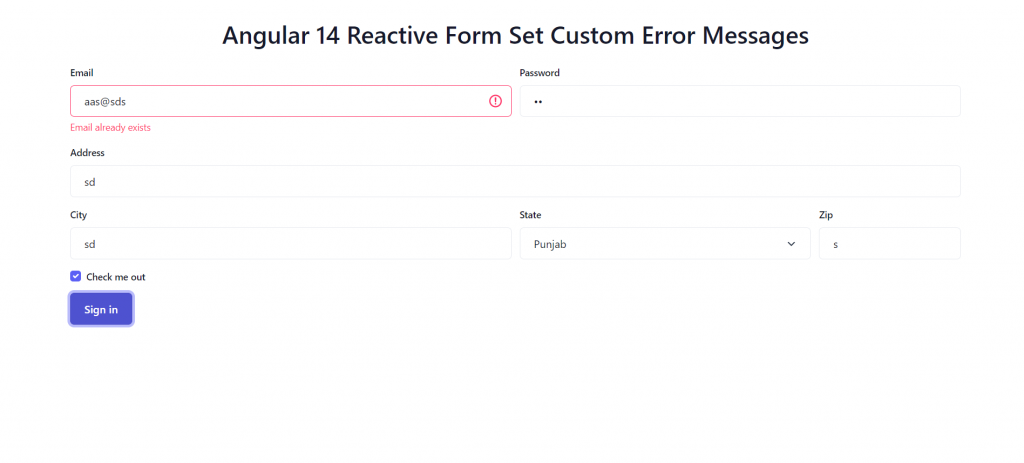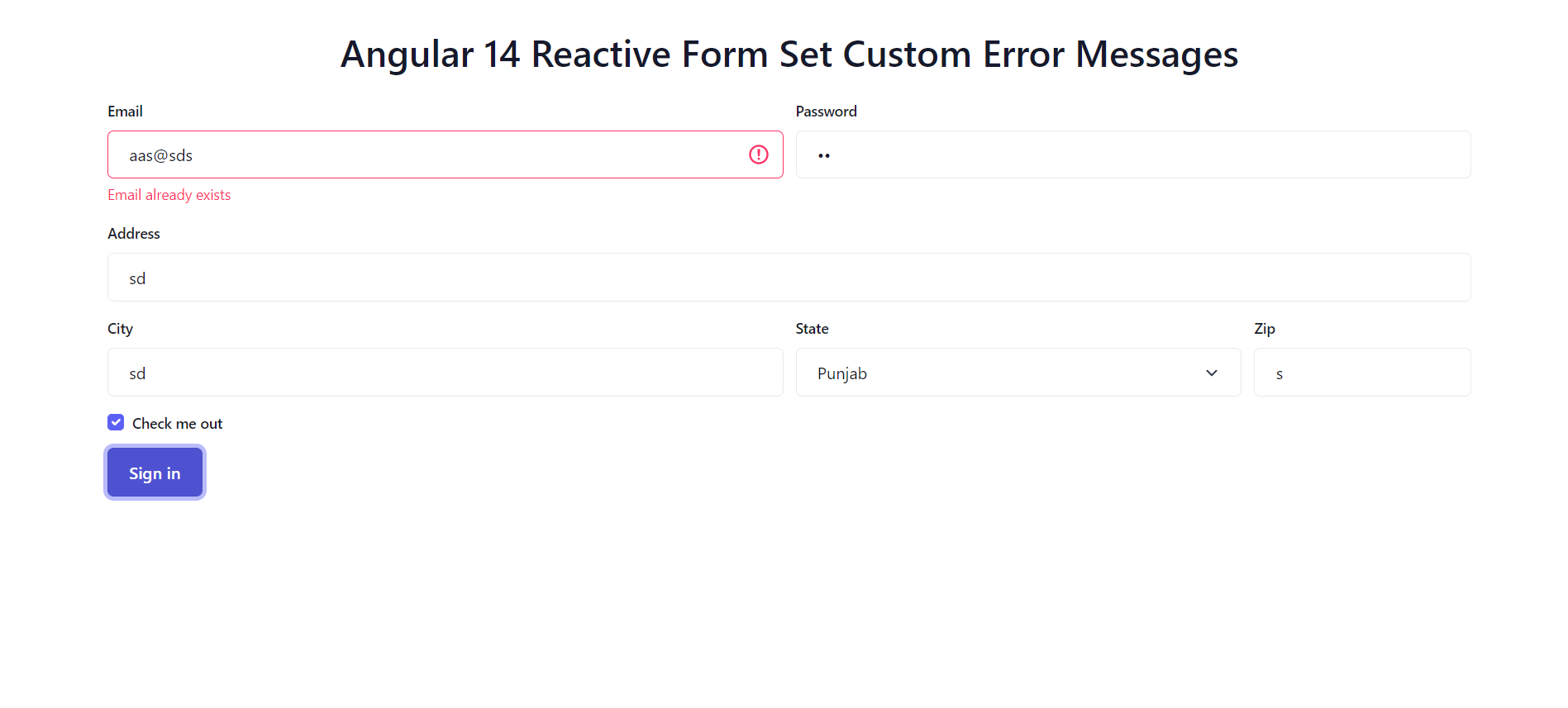Hello to all, welcome to therichpost.com. In this post, I will tell you, Angular Reactive Form Set Custom Error Messages Working Example.
Guys with this we will cover below things:
- Angular 14 Reactive Form Implelemtnation.
- Reactive forms validation email with valid format.
- Reactive form checkbox validation.
- Angular14 Reactive Form Responsiveness with Bootstrap 5.

Angular14 came and if you are new then you must check below link:
Here is the code snippet and please use carefully:
1. Very first guys, here are common basics steps to add angular 14 application on your machine and also we must have latest nodejs latest version installed for angular 14:
$ npm install -g @angular/cli $ ng new angularform // Set Angular 14 Application on your pc cd angularform // Go inside project folder
2. Now run below commands to set bootstrap 5 modules into our angular 14 application for responsiveness (optional):
npm install bootstrap npm i @popperjs/core
3. Now friends we just need to add below code into angularform/angular.json file (optional):
"styles": [
...
"node_modules/bootstrap/dist/css/bootstrap.min.css"
],
"scripts": [
...
"node_modules/bootstrap/dist/js/bootstrap.min.js"
]
4. Now guys we will add below code into our angularform/src/app/app.module.ts file:
...
import { ReactiveFormsModule } from '@angular/forms';
@NgModule({
...
imports: [
...
ReactiveFormsModule,
],
providers: [],
bootstrap: [AppComponent]
})
export class AppModule { }
5. Now guys we will add below code into our angularform/src/app/app.component.ts file:
import { Component } from '@angular/core';
import { FormBuilder, FormGroup, Validators } from '@angular/forms';
@Component({
selector: 'app-root',
templateUrl: './app.component.html',
styleUrls: ['./app.component.css']
})
export class AppComponent {
title = 'angular14demos';
//Form Validables
registerForm:any = FormGroup;
submitted = false;
//custom error message bolean variable
customEmailErrorMessage = false;
constructor( private formBuilder: FormBuilder){}
//Add user form actions
get f() { return this.registerForm.controls; }
onSubmit() {
this.submitted = true;
// stop here if form is invalid
if (this.registerForm.invalid) {
return;
}
//True if all the fields are filled
if(this.submitted)
{
//demo how we can set custom error messages very easily
this.registerForm.controls['email'].setErrors({ incorrect: true});
this.customEmailErrorMessage = true;
}
}
ngOnInit() {
//Add User form validations
this.registerForm = this.formBuilder.group({
email: ['', [Validators.required, Validators.email]],
password: ['', [Validators.required]],
address: ['', [Validators.required]],
city: ['', [Validators.required]],
state: ['', [Validators.required]],
zip: ['', [Validators.required]],
checkmeout: ['', [Validators.requiredTrue]]
});
}
}
6. Finally we will add below code into our angularform/src/app/app.component.html file:
<div class="container p-5">
<form class="row g-3" [formGroup]="registerForm" (ngSubmit)="onSubmit()">
<div class="col-md-6">
<label for="inputEmail4" class="form-label">Email</label>
<input type="email" formControlName="email" class="form-control" [ngClass]="{ 'is-invalid': submitted && f.email.errors }" id="inputEmail4">
<div *ngIf="submitted && f.email.errors" class="invalid-feedback">
<div *ngIf="f.email.errors.required">Email is required</div>
<div *ngIf="f.email.errors.email">Email must be a valid email address</div>
<!--custom error message-->
<div *ngIf="customEmailErrorMessage">Email already exists</div>
</div>
</div>
<div class="col-md-6">
<label for="inputPassword4" class="form-label">Password</label>
<input type="password" formControlName="password" class="form-control" [ngClass]="{ 'is-invalid': submitted && f.password.errors }" id="inputPassword4">
<div *ngIf="submitted && f.password.errors" class="invalid-feedback">
<div *ngIf="f.password.errors.required">Password is required</div>
</div>
</div>
<div class="col-12">
<label for="inputAddress" class="form-label">Address</label>
<input type="text" formControlName="address" class="form-control" [ngClass]="{ 'is-invalid': submitted && f.address.errors }" id="inputAddress" placeholder="1234 Main St">
<div *ngIf="submitted && f.address.errors" class="invalid-feedback">
<div *ngIf="f.address.errors.required">Password is required</div>
</div>
</div>
<div class="col-md-6">
<label for="inputCity" class="form-label">City</label>
<input placeholder="Ludhiana" type="text" formControlName="city" class="form-control" [ngClass]="{ 'is-invalid': submitted && f.city.errors }" id="inputCity">
<div *ngIf="submitted && f.city.errors" class="invalid-feedback">
<div *ngIf="f.city.errors.required">City is required</div>
</div>
</div>
<div class="col-md-4">
<label for="inputState" class="form-label">State</label>
<select id="inputState" class="form-select" formControlName="state" [ngClass]="{ 'is-invalid': submitted && f.state.errors }">
<option value="">Choose...</option>
<option value="punjab">Punjab</option>
</select>
<div *ngIf="submitted && f.state.errors" class="invalid-feedback">
<div *ngIf="f.state.errors.required">State is required</div>
</div>
</div>
<div class="col-md-2">
<label for="inputZip" class="form-label">Zip</label>
<input type="text" formControlName="zip" class="form-control" [ngClass]="{ 'is-invalid': submitted && f.zip.errors }" id="inputZip">
<div *ngIf="submitted && f.zip.errors" class="invalid-feedback">
<div *ngIf="f.zip.errors.required">State is required</div>
</div>
</div>
<div class="col-12">
<div class="form-check">
<input value="" class="form-check-input" formControlName="checkmeout" [ngClass]="{ 'is-invalid': submitted && f.checkmeout.errors }" id="inputZip" type="checkbox" id="gridCheck">
<label class="form-check-label" for="gridCheck">
Check me out
</label>
<div *ngIf="submitted && f.checkmeout.errors" class="invalid-feedback">
<div *ngIf="f.checkmeout.errors.required">This is required</div>
</div>
</div>
</div>
<div class="col-12">
<button type="submit" class="btn btn-primary">Sign in</button>
</div>
</form>
</div>
Now we are done friends and please run ng serve command to check the output in browser(locahost:4200) and if you have any kind of query then please do comment below.
Note: Friends, I just tell the basic setup and things, you can change the code according to your requirements. For better understanding please watch video above.
Guys I will appreciate that if you will tell your views for this post. Nothing matters if your views will be good or bad.
Jassa
Thanks

Leave a Reply
You must be logged in to post a comment.